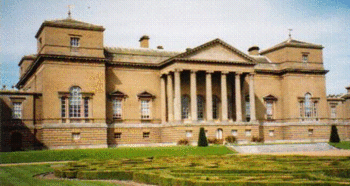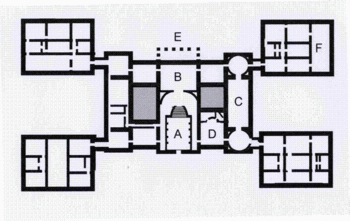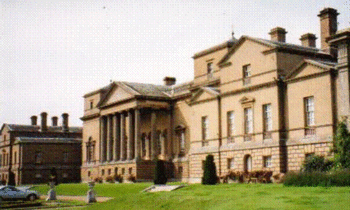Holkham Hall
2007 Schools Wikipedia Selection. Related subjects: Architecture

Holkham Hall, Norfolk, England, is an eighteenth century country house constructed in the Palladian style for Thomas Coke 1st Earl of Leicester by the architect William Kent with advice from the architect and aristocrat Lord Burlington. Burlington's Chiswick House is the prototype for many of England's Palladian revival houses.
Holkham Hall is one of England's finest examples of the Palladian revival style of architecture, the severity of the design being closer to Palladio's ideals than many of the other numerous Palladian style houses of the period. The Holkham estate, formerly known as Neals, had been purchased in 1609 by Sir Edward Coke, the founder of the family fortune. It remains today the ancestral home of the Coke family, Earls of Leicester of Holkham.
Architects and patron
The builder of Holkham was Thomas Coke, later 1st Earl of Leicester, born in 1697. A cultivated, wealthy man, he had made the Grand Tour in his youth, being away from England for six years between 1712 and 1718. It is thought he first met Burlington, the aristocratic architect at the forefront of the Palladian revival movement in England, and William Kent in Italy in 1715; it is possible that there in the original home of Palladianism, the idea of a new mansion at Holkham was conceived. Returning to England with not only a newly acquired library but also art and sculpture collections with which to furnish the planned new mansion, Coke made disastrous investments in The South Sea Company. The resultant notorious losses when the South Sea Bubble burst in 1720 were to delay the building of Coke's planned new country estate for over ten years. Coke, who had been created Earl of Leicester in 1744, died in 1759 five years before the completion of Holkham, having never fully recovered his financial losses.
Although Colen Campbell was employed by Thomas Coke in the early 1720s, the oldest existing working and construction plans for Holkham were drawn by Matthew Brettingham under the supervision of Thomas Coke, in 1726. These followed the guidelines and ideals for the house as defined by Kent and Burlington. The Palladian revival style chosen was at this time making its return in England. The style had made a brief appearance in England, before the Civil War, introduced by Inigo Jones, but following the Restoration had been replaced in popular favour by the Baroque style. The "Palladian revival", popular in the 18th century, was loosely based on the appearance of the works of the 16th century Italian architect Andrea Palladio. It did not, however, adhere to his strict rules of proportion. The style eventually evolved into what is generally referred to as Georgian, still popular in England today. It was the chosen style for numerous houses in both town and country. Holkham is exceptional for its severity of design, and closer (than most) adherence to Palladio's ideals.
Thomas Coke, who masterminded the project, delegated the on-site architectural duties to the local Norfolk architect Matthew Brettingham, who was employed to be the on-site clerk of works. Brettingham also seems to have been the retained estate architect prior to this date. William Kent was mainly responsible for the interiors of the Southwest pavilion, or family wing block, particularly the Long Library. Kent also produced a variety of alternative exteriors, suggesting a far richer decoration than Thomas Coke wanted. In 1734, the foundations were begun, and building was to continue for thirty years until in 1764 the great house was completed.
The design of Holkham

The Palladian style was beloved by Whigs such as Thomas Coke, who liked to identify themselves with the Romans of antiquity. William Kent was responsible for the external appearance of Holkham. He based the design on Palladio’s unbuilt Villa Mocenigo, as it appears in his I Quattro Libri dell'Architettura, but with certain modifications. The plans for Holkham were of a large central block of two floors only, containing on the piano nobile level a series of symmetrically balanced state rooms situated around two courtyards. No hint of these courtyards is given externally; they are purely for lighting rather than recreation or architectural value. This great central block was in turn flanked by four smaller, rectangular blocks, or wings, and at each of its corners linked to the main house not by long colonnades as would have been the norm in Palladian architecture, but by short two-storey wings of only one bay.
External appearance
The external appearance of Holkham can best be described as a huge Roman palace. However, as with most architectural designs, it is never quite that simple. Holkham is a Palladian house, and yet even by Palladian standards the external appearance of Holkham is austere and devoid of ornament (see illustration). The reasons for this can almost certainly be traced to Coke himself. The on-site, supervising architect of Holkham, Matthew Brettingham, related that Coke required and demanded "commodiousness", which can be interpreted as comfort. Hence rooms that were adequately lit by one window, had only one, as a second may have improved the external appearance but would have made a room cold or draughty. As a result the few windows on the piano nobile, although symmetrically placed and balanced, appear lost in a sea of brickwork; albeit these yellow bricks were cast as exact replicas of ancient Roman bricks expressly for Holkham. Above the windows of the piano nobile, where on a true Palladian structure the windows of a mezzanine would be, there is nothing. The reason for this is the double height of the state rooms on the piano nobile; however, not even a blind window is permitted to alleviate the severity of the facade. On the ground floor, the rusticated walls are pierced by small windows more reminiscent of a prison than a grand house. One architectural commentator, Nigel Nicolson, has described the house as appearing as functional as a Prussian riding school.
The principal, or South facade, is 344 feet (104.9 m) in length (from each of the flanking wings to the other), its austerity relieved on the piano nobile level only by a great six- columned portico. Each end of the central block is terminated by a slight projection, containing a Venetian window surmounted by a single storey square tower and capped roof, similar to those employed by Inigo Jones at Wilton House nearly a century earlier. Interestingly, a near identical portico was designed by Inigo Jones and Isaac de Caus for the Palladian front at Wilton, but this was never executed.
The flanking wings (illustrated right), containing service and secondary rooms, are externally identical: three bays, each separated from the other by a narrow recess in the elevation. Each of the three bays is surmounted by an unadorned pediment. The composition of stone, recesses, pediments and chimneys of the four blocks is almost reminiscent of the English Baroque style in favour ten years earlier, employed by Sir John Vanbrugh at Seaton Delaval Hall. One of these wings, as at the later Kedleston Hall, was a self-contained country house to accommodate the family when the state rooms and central block were not in use.
Interior
Inside the house, the Palladian form reaches a height and grandeur seldom seen in any other house in England—a deliberate contrast to the austere facades. What is remarkable is that this unique grandeur is obtained with an absence of excessive ornament. The house is entered through the "Marble" Hall (the chief building fabric is in fact Derbyshire alabaster), modelled by Kent on a Roman basilica. The room is 50 feet (15.2 m) from floor to ceiling and is dominated by the broad white marble flight of steps leading to the surrounding gallery, or peristyle: here alabaster Ionic columns support the gilded roof and ceiling, copied from a design by Inigo Jones, inspired by the Pantheon in Rome. The fluted columns are thought to be replicas of those in the Temple of Fortuna Virilis, also in Rome. Around the hall are statues in niches; these are predominantly plaster copies of ancient classical deities.
The hall's flight of steps lead to the piano nobile and state rooms. The grandest, the saloon, is situated immediately behind the great portico, with its walls lined with Genoa velvet and a coffered, gilded ceiling. In this room hangs Rubens's Return from Egypt. On his Grand Tour, the 1st Earl acquired a collection of Greek and Roman sculpture which is contained in the massive "Statue Gallery", which runs the full length of the house north to south. The North Dining Room, a cube room of 27 feet (8.2 m) contains an Axminster carpet that perfectly mirrors the pattern of the ceiling above. A bust of Aelius Verus, set in a niche in the wall of this room, was found during the restoration at Nettuno. A classical apse gives the room an almost temple air. The apse in fact contains concealed access to the labyrinth of corridors and narrow stairs that lead to the distant kitchens and service areas of the house. Each corner of the east side of the principal block contains a square salon lit by a huge Venetian window, one of them — the Landscape Room — hung with paintings by Claude Lorrain and Nicolas Poussin. Much of the furniture in the state rooms was also designed by William Kent, in a stately classicising baroque manner.
So restrained is the interior decoration of the state rooms, or in the words of James Lees-Milne, "chaste", that the smaller, more intimate rooms in the family's private south-west wing were decorated in similar vein, without being overpowering. The long library running the full length of the wing still contains the collection of books acquired by Thomas Coke on his Grand Tour through Italy, where he saw for the first time the Palladian villas which were to inspire Holkham.
Holkham today
The cost of the construction of Holkham is thought to have been in the region of £90,000 (allowing for inflation, approximately £8m in 2006). This vast cost nearly ruined the heirs of the 1st Earl, but had the result that they were financially unable to alter the house to suit the whims of taste. Thus, the house has remained almost untouched since its completion in 1764. Today this perfect, if severe, example of Palladianism is a thriving private estate. Though open to the public for tours, it is still the family home of the Earls of Leicester of Holkham.

